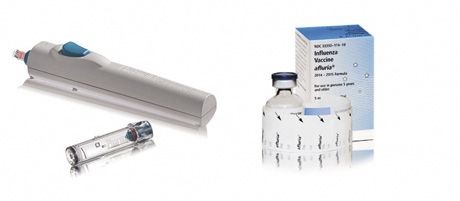New device takes fear out of influenza vaccinations
Adults can protect themselves against flu with a needle-free option. There's a benefit for vaccine administrators too - no needle sticks.
Starting this fall, pharmacists will be able to provide influenza vaccinations to adults 18 to 64 years of age with the first needle-free delivery device approved by FDA.

James BowmanIn mid-August, PharmaJet Inc., the company that developed the technology, and bioCSL Inc., the manufacturer of Afluria, an inactivated influenza vaccine, received FDA approval for the PharmaJet Stratis 0.5mL Needle-Free Jet Injector for administration of Afluria in patients who want protection during this year’s flu season.
“We hope that this option can facilitate broader immunization coverage,” said James A. Bowman, PharmaJet’s president and chief commercial officer, who spoke with Drug Topics during the 2014 NACDS Total Store Expo meeting in Boston.
The numbers
“The CDC recommends that all citizens over six months old get a flu shot, but for the last five years the flu vaccine rate has been hovering at about 40%. Of those who forgo immunization, about one-third do so through aversion to or fear of needles,” Bowman said.
The CDC’s surveillance of influenza vaccination coverage in the United States showed an increase in uptake for adults ≥18 years from 33% in 2007–2008 to 38% in 2011–2012. Influenza vaccination coverage tends to increase as patients reach middle age and retirement age, the CDC reported.
Coverage in the 2011-2012 season was about 26% for young adults between the ages of 18 and 49 years. The rate reached 44% among individuals aged 50 to 64 years, and climbed higher to almost 70% in patients aged 65 and older. However, this is far below the Healthy People 2020 target of 70% for all adults 18 years of age and older.
How it works

The needle-free PharmaJet Stratis 0.5 mL Jet Injector can be used to administer Afluria vaccine to patients ages 18 to 64.A reusable injector, the PharmaJet device delivers a single dose of Afluria in a disposable cartridge without the need of an external power source. When the PharmaJet is in contact with the patient’s upper arm, a steady stream of fluid penetrates the skin, delivering an intramuscular injection in about one-tenth of a second. With a vial adapter, the device can be used with vaccine vials.
During the 2012-2013 influenza season, in one of the largest injector studies ever made, 1,250 individuals received vaccination with Afluria either by means of the needle-free jet injector (627) or by needle and syringe (623). The median age was 41 years in the jet injector group and 42 years in the group receiving traditional needle injection. Women made up the majority of the study participants - 72% in the jet injector group and 69% in the traditional needle/syringe group. Most were Caucasian - 88% in the jet injector group and 85% in the comparator group.
“The immune response to Afluria given by needle-free injector met the criteria for noninferiority for all six coprimary endpoints,” wrote investigator Linda McAllister and her colleagues in a report published online in The Lancet, May 30, 2014.
“The jet injector group met the geometric mean titre criterion for noninferiority for the A/H1N1, A/H2N2, and B strains,” McAllister wrote. She noted that the jet injector group also met the seroconversion rate criterion for noninferiority for the three strains.
Side effects
In the clinical study, participants who received the inactivated influenza vaccination by jet injection experienced more localized reactions than those who received their vaccinations by needle and syringe. Immediate complaints of pain, tenderness, itching, redness, and swelling were more frequent in the jet injector group. However, most were mild reactions that did not prevent daily activities.
Up to three days following vaccination, 90% of the jet injector group and 78% of the comparator needle/syringe group had mild tenderness at the site of the injection. At four to six days, 13% of the jet injector group had mild tenderness in their injected arms compared with only 4% in the comparator group.
Mild swelling and redness were also noted at a higher rate in the jet injector group at days 0-3 following vaccination (65% and 60%, respectively). In the comparator group, only 20% reported mild swelling and 19% redness in the first three days following the needle/syringe vaccination. At four to six days after vaccination, mild swelling and redness in the jet injector group fell to 9% and 11%, respectively. In the comparator group at four to six days post-vaccination, mild swelling and redness declined to 2%.
None of the participants withdrew from the study because of side effects.
Other benefits
In addition to a good safety and acceptability profile for patients, the needle-free jet injector also offers greater safety to vaccine administrators through elimination of possible needle-stick injuries. The Occupational Safety and Health Administration has data indicating that as many as 800,000 accidental needle-stick injuries occur per year, according to Bowman.
“With broader use of the PharmaJet injector, we eliminate those needles and the possibility for needle-stick injuries, eliminate the risk of needle reuse or cross-contamination,” Bowman said. “So it is safe for the patient and for the caregiver.”
Newsletter
Pharmacy practice is always changing. Stay ahead of the curve with the Drug Topics newsletter and get the latest drug information, industry trends, and patient care tips.